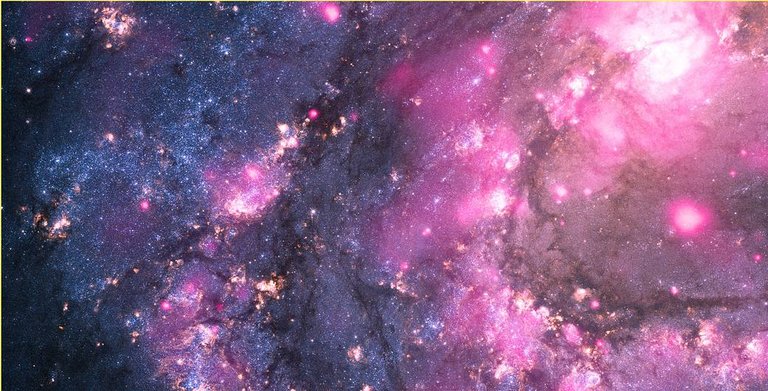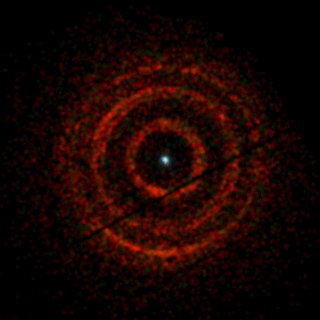galaxy and discuss about a recent study which basically suggested that we finally discovered the various types of black holes very close to the actual center of the Milky Way Galaxy.Hello wonderful people on #Steemit! A very warm greetings to one and all present here. Hope you all are doing well in your life! In today's article, we're going to be discussing about going to the middle or the center of our

Hope you people will read my article and provide your valuable suggestions and thoughts by commenting below. So, without any further delay let us start the exploration!!
This new study actually is based on the theory that suggests that right next to the central black hole; basically [Sagittarius A]* within about six to may be ten light years there should be a tremendous amount of black holes. Specifically, close to about 10000 black holes. So, let's actually first go to the [Sagittarius A]* which is right in the center of this very large globular cluster and there if I go to a distance of about ten light-years within this distance; there should be a tremendous amount of black holes. Now, for the longest time we couldn't really find any. As a matter of fact, as of today there's only about may be 60 or so black holes were discovered in the entire galaxy and that's not really even close to the theory and this so-called density cusp as it's known has been basically nothing but a theory.

Now, in Space Engine if I was to come closer to the central black hole and to then search for any kind of black holes within 20 light-years away from us or even more than 20 light-years; I can actually even put 50 light-years. I will unfortunately find nothing. So, even this is currently set to basically only detect black holes with a much lower frequency. But the reality is that most Scientists or most Astrophysicists believe that there are tremendous variety of black holes within about one parsec away from [Sagittarius A]. In other words within about four light-years of the central black hole there should be close to about 20,000 of these beautiful objects.

Now, where exactly are they? Well! It turns out and this is coming from a very recent paper by Charles J Haley, Kaya More and Franz E. Bauer and a few other people. This was actually posted in Nature magazine very recently in April of 2018 turns out that they actually use previous data from the Chandra telescope and what they did was look at the binary. Specifically, the so called x-ray binaries similar to the Cygnus binary. Basically, these are binaries containing a black hole and another object and normally these can be a relatively energetic. But they were looking at just the regular binaries that may actually have black holes that would have an accretion disk and these accretion disks in binaries will actually produce a little bit of x-rays and so they actually just looked at these more or less not so energetic black hole binaries and what they discovered was basically at least a dozen of these objects within about one parsec of the central black hole. They actually even took a photo of it which you can see just above and so there you can find [Sagitarius A]* and you can see every red spots that you see in that image is basically an x-ray coming from most likely a binary black hole.

In other words, they were able to discover quite a lot of these unusual binaries in this region that we haven't really seen before and using statistics we can actually estimate that there's probably a lot more singular black holes out there. So, even though they want to discover about a dozen or so binary black holes. Just based on the understanding of how black holes form and how binary systems work we think that there is probably something like at 10,000 or possibly 20,000 singular black holes hiding out there very close to [Sagittarius A].

Now, this is within a distance of about four or so light-years. So that's actually not very close and if you want you can simply see in Universe Sandbox so that you can get an idea of how far away it actually is in terms of distances and in the Universe Sandbox if we place [Sagittarius A] right in the middle we have place may be a few smaller black holes at a distance several light-years and that actually pretty far away. So, there's probably about 30-40 black holes we will discover now and these were all binary black holes. But at a relatively large distance and it's actually somewhat similar to distance between our Sun and the closest star to us which is Proxima Centauri and Proxima B is the planet around that star.

So, it's not that close. But like I said within this distance they expect at least 20,000 black holes which is actually quite a lot. So, even though there are actually also stars here but there is actually a tremendous amount of these Black holes as well and this is what we refer to as the density cusp. Mostly, because we believe that lot of these black holes came here from the outer edges of the inner galaxy and they actually ended up closer and closer to [Sagittarius A]* and a lot of them actually do end up following to [Sagittarius A]* . Thus increasing its mass! At least that's the theory behind it.

But because these are black holes; we won't really see them because they don't really emit any light and if they're not in a binary system they don't even have any accretion disk to basically provide any other energy either. They would only be emitting light if and only if something actually falls into them. Well! That's all I wanted to discuss in this article and now we know that the unusual region around [Sagittarius A]* actually possesses quite a lot of invisible black holes that we don't really see. In other words, even though this was a theory until now. We have now been able to detect at least a dozen unusual binary systems which are quite rare usually where there is or at least might be some sort of a black hole that is emitting x-ray radiation. There is really no better explanation for what it will be and so that's all I wanted to share with you all in this post and hopefully you have learnt something from it.
Thank you so much for reading this article guys and if you've enjoyed reading the information in this article, don't forget to Upvote and Resteem for those who enjoys reading space articles and wants to learn more through the information provided here!!



Very interesting. I wonder what makes all those thousands of black holes separated and not collapsing into a bigger one. They should go super super fast, or is there something else, like space-time behaving very differently among all these powerful entities together. Poor fabric of space-time.
Space Engine should be updated then I want to go to a planet surrounded by all those black holes, if possible ;) I love it.
Hi @hedac! I hope you are doing well. I am glad you liked it. Thanks a lot for the interest you shown reading the article.
Well, as I have mentioned though there are ten thousands of black holes detected in the Milky way galaxy but they are very far away from each other at present because of which they are not collapsing at this stage. They are many light years away because of which it might take many years to come closer to each other and collapse and once they came closer to each other after collapsing they will start getting super massive.
I agree that the space engine need to be updated because at present it is only able to detect only low frequency. The space engine needed to be made more efficient and updated because they sometimes hang as well as we put more number of objects for simulation together.
But I hope very soon we will be able to see an updated version of space engine!
Cheers!! 😇
For me, being 20,000 black holes within a radius of only 6 light years is like being super close together, considering the size of the galaxy. And the fact that the galaxy is almost the age of the Universe, they probably had time to collapse together already. Unless, as you said, they constantly come from the inner galaxy rings, and are on their way to the centre. This theory makes sense to me. A small black hole maybe can eat stars, but a super massive black hole can eat other black holes. But if these 20,000 black holes are orbiting Sagittarius A for millions and millions of years it would be amazing. Time must be so messed up there :D It's all so interesting!
Cheers!
After going through the research paper I only could think of the theory that they constantly come from the outer edges of the inner galaxy, and are on their way to the centre. But the researchers are not 100% sure about it. They have calculated all these from the past data they had obtained from Chandra Telescope. We need to wait for some time to see the big picture! ;)
I am waiting for @lemouth to have a discussion with him as well on this so that there might be some other reason as well to which our hands haven't reached and who knows we can even know something new about it from him!
Dear @star-vc,amusing photography.Your thought is so creative.Keep sharing Your creativity dear.We can learn from your skill.Best of luck dear.
Hi @shanto15! Thanks a lot for the appreciation. I am glad you liked it. Good luck for your journey too in #Steemit. 😇
@star-vc : I need to point out here is that regarding the license attribution of images. Just mentioning image source at the end does'nt complete your job. So please verify the license of each image, credit the author and link the license info. Three things are always necessary:
I am giving a snapshot from CC-ver-2 page here:

Let me know your opinion.
--
@dexterdev
Hi @dexterdev! Thanks for letting me know about that but I generally use the pictures from NASA's website for which I clearly attach the source link with it. Moreover, as far as I know pictures from NASA's website are free to use! But thanks for letting me know bro about it. Next time onwards I will try to implement it!
Can you please explain me a bit more about license attribution link? I haven't used earlier. So don't have much idea about it! 😊
You can just follow the comment above which I posted. That is a detailed one. Coming up to your query there are Non-NASA images in your image. See the 4th image (black hole one). It is CC by-SA 3. You can get the author and license details in the wiki link.
Just follow the 3 rules which I mentioned above. I have given an example for you. Actually, there is nothing more to it(at least in a minimal way). If you are confused about an image license, the better thing is to look for a usable image.
If you are still confused you can talk to me in discord. To be honest I have nothing new to explain.
In my opinion, you should edit this post itself, incorporating the changes.
Yup bro the 4th one is the gif file which I have taken from the Wikipedia and I did the changes as you suggested! 😊
I just happen to be listening to the Interstellar soundtrack when reading this. Couldn't be more perfect!
Their interpretation of black holes is the most accurate depiction known to man - the scientific advisor just won a nobel prize and won bets against Stephen Hawking... and they released a scientific paper based on the movie and its interpretation of black holes...
Good read!
(Be careful how you use the words 'just a theory')
Hi @mobbs! I can't express my happines today seeing your comment in my post! This is the first time I received your comment. I am glad you liked it! 😇
Thanks for sharing the information about the Scientific advisor who won the Nobel Prize regarding scientific paper based on the movie and it's interpretation of black holes!
I guess there is a big news regarding black holes we will hear soon! 😊
Amazingly writing skill. I wish i could be able to write like you :)
Hi @rifkan! Long time no see.. Thanks for the appreciation bro! I am glad you liked it! But I am not as good as you bro! I loved your recent article which I have even resteemed in my blog few days back!
Cheers!! 😊
Thanks. I liked your post but, one thing though, when you say black hole binary it means something else. It should be a binary black hole which means two black holes together. But in the case of a binary star, there can be two stars in a system where they orbit around their center of mass. It can happen one is neutron star another kind of star or maybe one black hole the other is different kind of stars when you say black hole binary it indicates those things although there is no such binary star called black hole binary. I loved reading the article a lot of new things to know about.
Thanks for pointing this and making me correct bro! It was a silly mistake held unconciously. :)
Yeah, i understood that :) cheers
Cheers!! :)
Congratulations, your post has been selected for TecNews! Thank you for your contribution!
It's my pleasure! Thanks. 😊